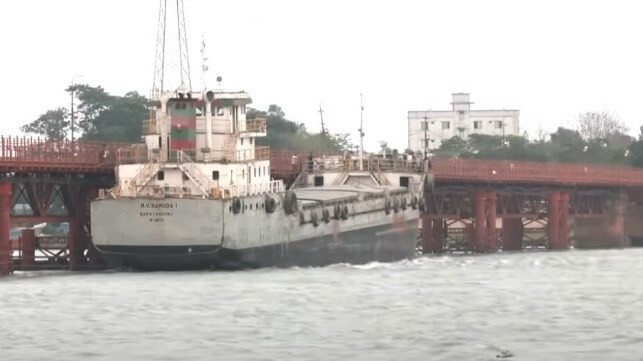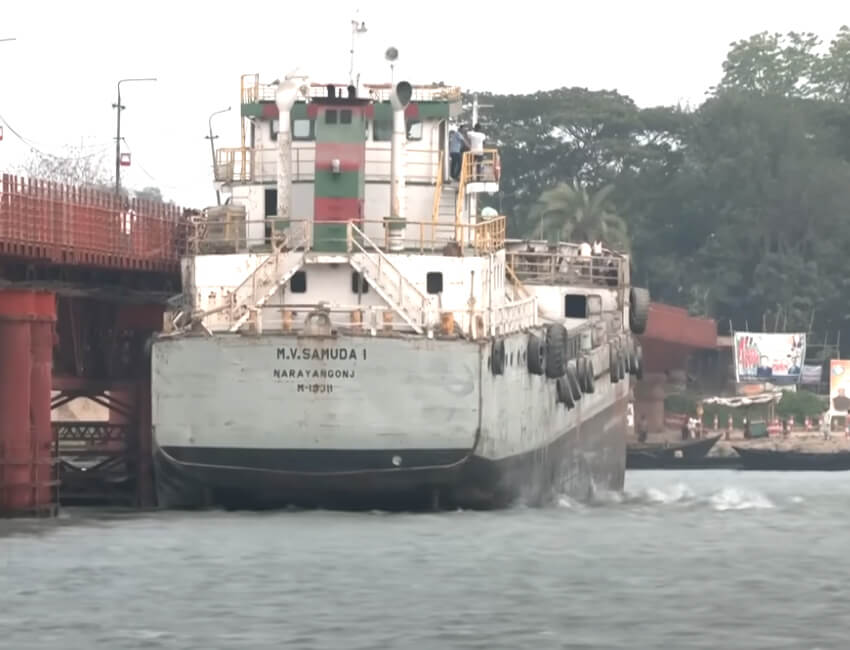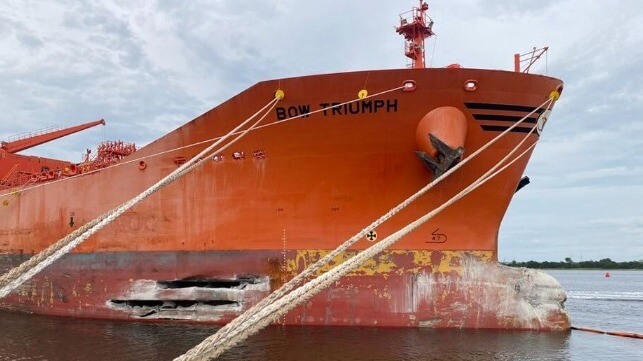Video: Drifting Cargo Ship Hits Railway Bridge in Bangladesh

It happened again, this time as a small cargo ship out of control drifted along one of the main waterways in the Bangladesh city of Chattogram before becoming pinned alongside the bridge. Both the bridge and ship suffered some damage with the survey work still underway.
According to officials they were trying to determine if the cargo ship named Samuda-1 had broken away from its moorings at a nearby shipyard on the Karnaphuli River or if it was a mistake by the helmsmen on the ship. Some reports said the vessel appeared to be without power and uncrewed but TV images showed at least one person aboard the vessel.
Eyewitnesses told the local TV station that the vessel was seen floating from the AK Khan dockyard on the western side of the river. There were strong winds which made it difficult to control the vessel and it struck the Kalurghat Railway Bridge. The ship was pinned up against the bridge due to the strong current in the river while officials were arranging for a salvage vessel.

It is reported to be one of the main bridges crossing the river and providing rail and vehicle connections to other areas of the country. The bridge was completing nearly eight months of renovations to support the opening of a new railway line.
Officials reported that there were several bent sections on the bridge but they believed it was overall minor damage. Rails along the deck of the vessel were also twisted but they were awaiting the salvage to remove it from the bridge to determine if there was more damage.
Shoaling and Bank Effect Caused Ship to Hit Navy Fuel Pier

The National Transportation Safety Board has concluded an investigation into a serious allision involving a tanker and a Navy fuel pier at a base in South Carolina, and has determined that bank effect was the primary cause.
On the afternoon of September 5, 2022, the product tanker Bow Triumph got under way from a private petroleum terminal on the Cooper River, upstream of Joint Base Charleston. The river is a winding tidal waterway, with sharp bends and branching tributaries. With a docking pilot aboard and a harbor pilot at the conn, Bow Triumph got under way at about 1530, headed for another product terminal a few miles downriver. The pilot had made this transit about 500 times before, including voyages aboard the same class of tanker, and had piloted more than 10,000 ships over the course of his 30-year career.
The ship passed two bends without difficulty. As the Triumph approached the third bend, the pilot maneuvered towards the east bank (left descending bank), anticipating that a tidal current would push the ship towards the west bank as it rounded the bend. Unbeknownst to the bridge team, the ship was now transiting closer to the east bank than any ship in the previous year, based on AIS data.
At 1600, the pilot began the turn to port. At first the ship responded properly, but then the rate of turn stalled. The pilot increased RPM to full ahead and gave a series of escalating rudder commands, culminating at a full Becker rudder angle of 90 degrees (beyond the maximum possible on typical vessels).
In the close confines of the narrow waterway, the situation began to change quickly. By 1601:24, it was evident that the heading had only changed by two degrees, and the vessel was not making the turn; instead, it was headed for Naval Weapons Station Charleston's Pier Bravo, a finger pier which protrudes at an angle out into the river.
At this point, the pilot ordered the crew to drop anchor and put engines astern. Less than a minute later, at 1602:20, Bow Triumph's bow allided with Pier B, destroying a 300-foot section of the wharf.
Bow Triumph sustained about $2.5 million in hull damage, and the pier section had to be demolished and replaced at a cost of $29 million. (This January, the bulker Hafnia Amessi hit the same pier, causing more than $3 million in damage.)
On drydocking, investigators noticed that Bow Triumph was missing her hull coating in several areas, an indication that she may have touched bottom. The waterway is known for rapid shoaling, and a Corps survey in May 2022 found that sediment accumulation had reduced the water depth by more than 10 feet. According to the NTSB, the survey that the pilot relied upon was from November 2021, 10 months before the casualty voyage.
Given the data, NTSB concluded that the ship experienced bank effect when it transited so close to the east side of the channel and passed over the shoal. Bank effect occurs when a vessel transits close by a riverbank, shoal or canal bank, and creates a pressure difference between each side of the ship. This hydrodynamic phenomenon can push the ship's bow away and pull the ship's stern towards the bank, exerting a turning force - in this case, to starboard. The effect is stronger in shallow water and at higher speeds. The incoming tidal current would have added additional turning force to the bow as the tanker exited the bend.
"Transiting in the center of the channel is prudent to avoid the risks associated with bank effect," concluded NTSB. "Pilots, masters, and other vessel operators should consider the risks in areas known for shoaling when planning transits."
No comments:
Post a Comment